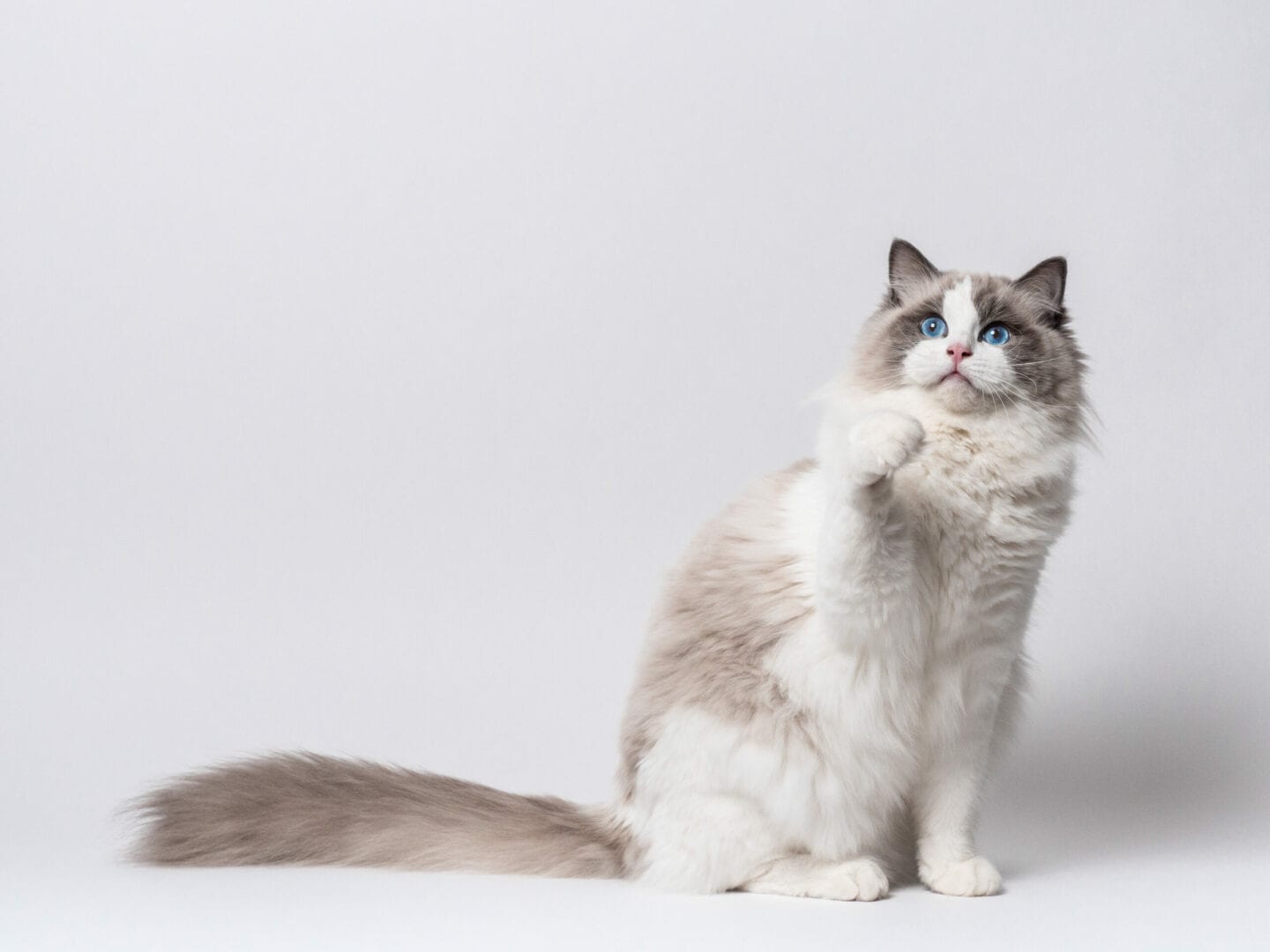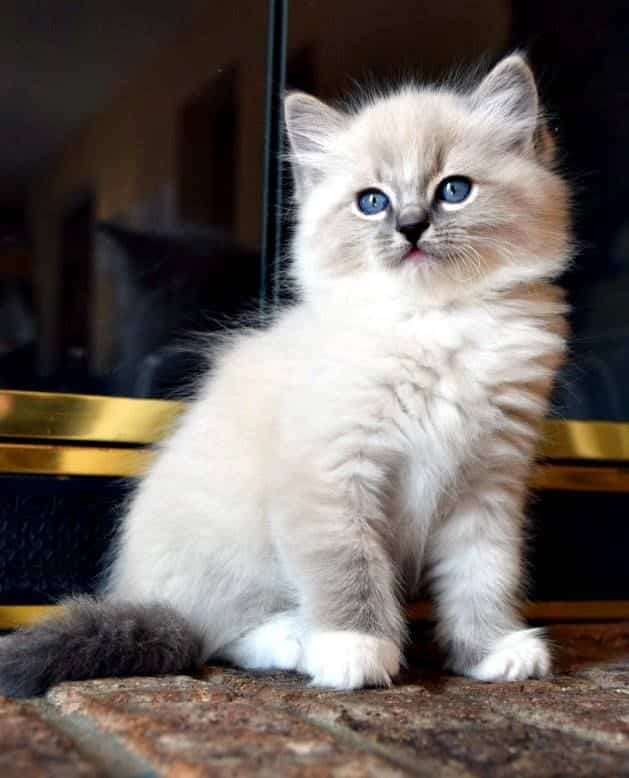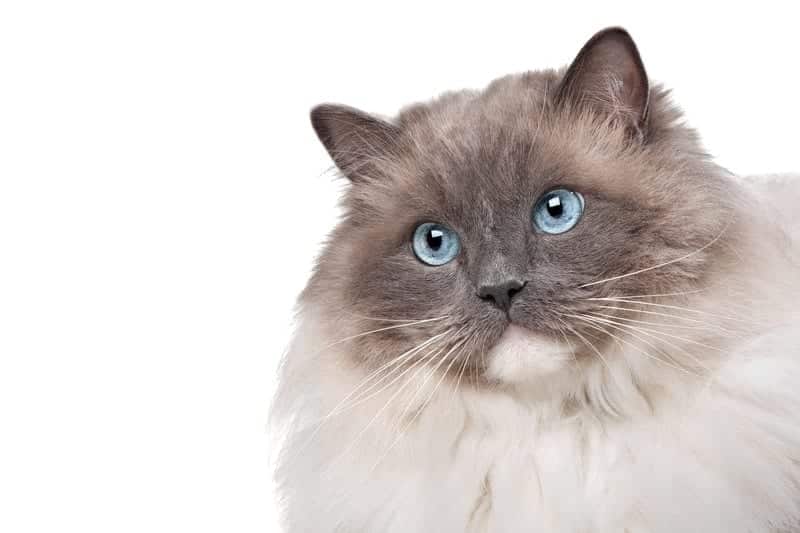The Ragdoll is one of the largest domestic breeds of cat, and, debatably, one of the most affectionate. This reputable breed is recognized for its mesmerizing blue eyes and signature coloring. The Ragdoll cat is a large, semi-longhaired, pointed breed of cat which refers to the points ( or the face, tail, ears, and legs) as notably darker than the body of the cat. They are more often known for the mesmerizing blue eyes that all purebreds exhibit. When a Ragdoll cat has eyes that are shades other than blue, this means they’re most likely a mixed breed rather than purebred.
As the name suggests, the memorable “ragdoll” moniker refers to this sweet breed that’s known for going limp when picked up and held. The founder of the breed, Ann Baker, started the whole process of creating the breed with her newly domesticated cat, Josephine. Unfortunately, Josephine was, supposedly, hit by a car that resulted in the feline being immune to pain. This gave Josephine the floppy “ragdoll” and pliant persona that’s since been discovered to occur in the memorable breed.

What A Personality
Known to have less interest in their fellow felines and household pets and a lot more interest in their human companions, Ragdoll kitties are the ultimate, dedicated feline. They have a knack for following their “person” or any human that snags their interest. This can mean an extra pair of eyes you didn’t want to have when taking a shower or using the bathroom, or it can include a softly snoozing friend by your side as you read your favorite novel.
Ragdoll cats are gentle felines and tend to be less inclined to use their snagging claws during playtime.
Grooming Time
As the Ragdoll cat has a notably plush coat, they require consistent grooming to prevent tangles and knots. The grooming also aids in rejuvenating the coat and getting rid of the old coat that changes during the seasons.
It’s recommended to use a steel comb grooming tool for the silky coat of the Ragdoll cat. Consistent grooming can result in a healthy coat and reduced shedding from the undercoat layers, which can frequently become matted.
It’s Play Time!
These inquisitive cats are quite intelligent! Many owners have taught their Ragdoll cats tricks that many would never think to assume a cat could do. Playing fetch, recall using their names, sitting…how cool is that?!
Mind you, these gentle cats aren’t the biggest jumpers, so teaching them how to do a jumping routine on layered boxes might not be the best idea.

All The Pretty Colors And Patterns
Fun fact: Ragdoll kittens are born pure white! As the kitten matures, the colors and patterns of the Ragdoll kitten finally begin to exhibit themselves. This is due to a genetic mutation that’s presented through temperature-sensitive pigment production, as explained further below.
Ragdoll cats come in a variety of colors, which is great for any cat lovers that enjoy a bit of variety in their favorite cat breed. For the Ragdoll breed, the standard of colors referred to by the Cat Fanciers Association must be cream, lilac, red, seal, chocolate, or blue. The pattern of color point can be lynx, solid, tortie, or torbie (which is a combination of lynx and tortie).
Bi-Color
Also known as “piebald”, a bicolor coat coloring refers to one primary color, like black, that is mixed with white. The additional white coloring can be magnanimous in its overtaking or as small as a little patch.
“Piebald” originates from the combination of “magpie” and “bald”. Magpies are notably a type of bird that holds the color black and white. “Bald” refers to white patches. This combination of words isn’t limited to only the primary color black with the necessary white color addition. Other colors, that must be solid, can replace the color “black” in the bicoloring requirement. Some examples of such would be brown, red, and grey.
Many cat breeds have this noted color type and are often seen in a domestic cat. Some examples of such breeds would be the Ragdoll, Maine Coon, British Shorthair, Norwegian Forest Cat, and the Scottish Fold.
Van
Defined by the Cat Fanciers Association, the van pattern holds the same scope of the bi-color or piebald gene except for the whole of the cat’s torso should be white. Along with the ears and forehead, there should be an inverted V pattern. The tail should be colored, not white, like black, cream, blue, or orange.
The standard allows for some color patches on the cat’s torso but prefers an all-white color exempt from any additional markings. Some breeds that hold the van pattern are the Turkish Van, Ragdoll, American Curl, Oriental Shorthair, and Devon Rex.

Mitted
There are many requirements for this specific coloring pattern.
A mitted Ragdoll cat or Ragdoll kitten will present, notably, colors on the ears, tail, mask, and legs. This doesn’t include the feet. For the cat to be considered “mitted”, it must have a white-colored chin that follows through down to the belly. The front feet should display “mittens” or white coloring and be mirrored in the circumference of the coloring. The white color should be included on the hind legs where the white must go up to the mid-thigh and no higher. The belly must also have a stripe of white. The nose, or “nose leather”, is required to match the color of the point.
Colorpoint
Often seen in the Siamese, the paws, face, ears, and tail of the cat present expressive color pigmentation; the colorpoint pattern refers to a genetic mutation that is “associated with temperature-sensitive pigment production”, according to UCDavis Veterinary Genetics Laboratory. It’s further explained that the pigmentation reduces in areas away from the “extremities” like the tail, ears, and paws, which results in darker coloring pigmentation. For other breeds, like the Burmese, this color pigmentation and differentiation can be more spread out when compared to the Siamese breed.
The colorpoint pattern is considered to be a form of partial albinism. When kittens are born, they’ll be noticeably white due to the warmth provided in the womb. As time passes, the darker color pigmentation will start to appear. Some breeds of cats that hold the colorpoint pattern include Siamese, Ragdoll, Balinese, and the Birman.

Lynx
Accepted in colorpoint Ragdolls by the Cat Fanciers Association, a lynx patterned cat comes from the mating of a tabby cat, or cat that holds the lynx point pattern, and a colorpoint cat. There’ll be the recognizable tabby striped patterns on the legs, tail, and head. This is combined with the distinct pigment point coloration and relatively pale torso unique to the Lynx color pattern.
This type of pattern is only acceptable in certain breeds, like the Ragdoll, many having some notable relation to the Siamese breed.
Tortie
The tortie, or tortoiseshell, color pattern in cat breeds refers to bi-colored coats with a seemingly shaped “tortoise” shell color pattern of the cat’s coat. Similar to calico-colored cats, the tortoiseshell pattern more often than not appears in females and rarely in males. This is due to the sex chromosome which holds the color-carrying genes.
A study was done linking the relationship between temperament, mainly aggressive behavior, and coat color. In this study, tortoiseshell cats were the main focus and after the completion of the study, the conclusion was that there were no conclusive results relating to coat color and temperament. So, all you tortie coat cat owners out there can rest easy. Your pretty kitty is no more likely to eat you in your sleep than any other coat color!
Some breeds of feline that exhibit this color pattern include the Ragdoll, Maine Coon, Persian, and the Cornish Rex.
Torbie
The cross-breeding of a tabby and tortoiseshell cat results in what is known as a “torbie”, or tortoiseshell-tabby, pattern. With loads of variation in their coats, this pattern holds tortoiseshell markings and tabby stripes. These cats are occasionally referred to as “patched tabbies” due to the cream or red patches paired with their tabby markings.

A Bit Of History
The gentle and affectionate Ragdoll breed was developed and mastered by Ann Baker of California in the 1960s. The elegant featured breed originated from domesticated free-roaming cats!
Josephine, a domestic longhaired white cat that Ann Baker discovered roaming her neighborhood, was bred with other free-roaming felines. This was to obtain the desired temperament and appearance that was noted from the endearing Josephine. Eventually, this resulted in the creation of the Ragdoll cat breed. Henceforth, the successors of Josephine would be nicknamed “the daughters of Josephine”.
It’s believed that this enigmatic and endearing cat breed has ties to Persian, Burmese, and Birman genetics.
Breed Continuance
The founder of the Ragdoll breed, Ann Baker, worked hard and as efficiently as possible to maintain structure and control over the breeding of this pliant feline. This resulted in the creation of the International Ragdoll Cat Association (IRCA) in 1971.
This started the strict breeding regulations and control over the continuation of this endearing feline.
The International Ragdoll Cat Association
A small cat breeding organization, the IRCA was founded by Ann Baker, the creator of the famous Ragdoll cat breed. Ann Baker went so far as to trademark the breed’s name, “Ragdoll”. This was meant to not only restrict the usage of this term in other cat breed standards but also to enforce strict standards on any that chose to breed or sell the breed of Ragdoll cat.
In the creation of the IRCA, Ann Baker went a step further in her ideals for a strict and regulated breed standard by spurning and refuting other traditional cat breeding associations. Since the death of Ann Baker in 1997, this organization has, unfortunately, steadily declined to an even smaller group. To this day, Ragdoll cats bred by the IRCA are not readily recognized by any major cat shows or cat breed organizations. This doesn’t make them any less loveable, though!
Denny and Laura Dayton
As a husband-and-wife team, Denny and Laura Dayton made a grand decision in spreading the notable and present-day recognized standard of Ragdoll cat. In 1975, they used a breeding pair of Ragdoll cats from the IRCA. They started breeding this pair of IRCA recognized Ragdoll felines to reach the standard of Ragdoll accepted today.
This standard of Ragdoll breed was, after a period of time, accepted by major recognized cat organizations like the Cat Fanciers Association (CFA) and the Fédération Internationale Féline (FIFe).

The Ragdoll Fanciers Club International
To this day, the Ragdoll Fanciers Club International is the largest known association for the Ragdoll cat breed and represents the Ragdoll cat breed in the Cat Fanciers Federation. The Ragdoll Fanciers Club International takes it upon themselves to represent the endearing Ragdoll breed, with the given responsibility of writing the Ragdoll breed standard and submitting proposals on the breed to the executive board at the Cat Fanciers Federation.
Starting at the Ragdoll Society, the Ragdoll Fanciers Club was founded by Denny and Laura Dayton, along with a select few other Ragdoll reputable breeders. Denny Dayton went on to become the President and his wife, the Vice President, of the Ragdoll Society. The purpose, or main goal, of the club, was to obtain an acceptance for the three different patterns for Championship Status in the Cat Fancy. By 1976, this pursued goal was achieved.
In 1978, the name of the club, Ragdoll Society, was changed to the Ragdoll Fanciers Club. As time passed, the club, unfortunately, died out until around the 1990s when a group of Ragdoll breeders decided to revive the club and its activities. Around this time, different colors were being introduced to the Ragdoll breed. The Ragdoll Fanciers Club wanted to do the opposite of straying from the original Ragdoll standard and strived to preserve this desired standard. Due to this heavy and epitomized standard, the Cat Fanciers Federation decided to amend the rules for the Ragdoll standard by only allowing pointed Ragdolls with the four traditional colors and three traditional patterns to be “registered and shown”.
Proceeding this earned standard for the Ragdoll breed, breeders at the Ragdoll Fanciers Club went forward in 2006 to request and vote for the inclusion of the red color gene and the lynx pattern. This was to achieve registration and championship status by the Cat Fanciers Federation. The vote was passed without argument.
It remains that the Ragdoll Fanciers Club desires to preserve the Blue-Eyed Pointed Breed of the Ragdoll cat breed.

The Ragamuffin
As Ann Baker was incredibly stringent with the strict standards of the breed, other groups sought to deviate from the IRCA because of the overtly strict breeding restrictions. As Ann Baker had trademarked the name “Ragdoll” for all cat breeds, this group went on to name their succinct breed of Ragdolls, “Ragamuffins”.
Concerned for genetic health issues due to long-term inbreeding, the group expanded its breeding of the Ragamuffin with the outcross inclusion of Persians, domestic long-haired cats, and Himalayans. This succeeded in illuminating the distinct features of the Ragdoll genes while improving personality and genetic health concerns.
Personality
Fond and friendly in personality, the Ragamuffin is a kind feline companion. They’re playfully sociable and affectionate, will remaining to be surprisingly intelligent. Like the Ragdoll, the Ragamuffin will notoriously go limp when held and is extremely cuddly and loving. They thoroughly enjoy spending time with their “person” or “people”, known to constantly follow them around the house to spend as much time with their people as they can.
Appearance
Heavy and muscular in stature, the Ragamuffin has medium-length plush fur that’s similar to a rabbit’s thick coat. The Ragamuffin comes in all sorts of patterns and coat colorizations and doesn’t restrict the inclusion or exclusion of the color “white” in the coat for the breed. The all-white Ragamuffin is more rare in coloring and, therefore, more desired.
The Cat Fanciers Association doesn’t accept colorpoint variations for the Ragamuffin.
Grooming
Though the coat of a Raggamuffin is plush and medium-length, there are low concerns of matting. Their coats are easy to maintain, thanks to the low frequency of tangles and matting in a Raggamuffin’s coat, with a consistent grooming schedule.
Activity Level
Like the Ragdoll, the Ragamuffin isn’t exceptionally active or athletic. They can be trained to fetch toys or come when called, and will happily spend time playing with their human, but they won’t go out of their way to climb the bookshelves anytime soon.

Conclusion
The Ragdoll breed is an endearing and affectionate feline, going as limp as a ragdoll when held. The breed has notoriously strict standards, but for good reason, as these loveable felines are wonderful companions with mesmerizing blue eyes. Since its inception, the founder and creator of the breed, the late Ann Baker, has made a solid foundation and followed strict standards to preserve this heart-warming breed of cat.
We hope this article was informative in its content on Ragdoll Kittens and Ragdoll Cats. Share this article with friends and family looking to learn more about the rarity and history of the Ragdolls. Happy cuddling!
